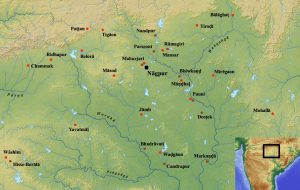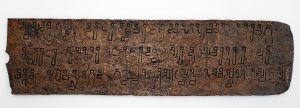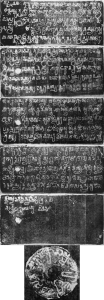INIG1152 Dubkund Inscription of VS 1152
INIG1152 vaiśākha śudi 5 Dubkund (Sheopur). On the base of pādukā in a Jaina temple. 4 lines, nāgarī, Sanskrit. Mentions double pādukā of Kāṣṭhasaṁgha mahācāryavarya śrī Devasena.
OB00181a Bidar Plates of Devasena (ring and seal)
OB00181d Bidar Plates of Devasena (plate 3)
OB00181c Bidar Plates of Devasena (plate 2)
OB00181b Bidar Plates of Devasena (plate 1)
OB00179 Hisse-Borala Demon’s Stone

Ancient Vidarbha showing find-spots of Vākāṭaka inscriptions. (Zenodo).

Hisse-Borala Inscription of Devasena. Nagpur, Central Museum (Zenodo)
OB00181 Bidar Plates of Devasena
OB00164 India Office Plate of Devasena

Copper-plate charter of Devasena (Zenodo).
IN00194 Bidar Charter of Devasena

The location of the original five copper plates and their ring are no longer known, but iron reproductions of the plates were created by a Bidri worker in Bīdar when the plates were brought to him by a villager from the Bechchali tālukā of the Bīdar district. Although the original plates are untraceable, the iron copies give an accurate copy of the charter which records Devasena’s donation of the village of Velpakoṇḍā in ‘favour of one Raddochha, a scholar of the four Vedas’ (Shastri 1997: 108). The inscription was issued from Vatsagulma. According to Shastri (1997: 109), this is the only known complete official grant of Devasena. Shastri (1997: 110) also argues that this plate is important because it may prove that the Vatsagulma branch of the Vākāṭakas spread into Karnataka, as the ending of the named village in the inscription may suggest.
IN00192 Hisse-Borala Inscription of Devasena


The four lined stone inscription was first published in 1963-64. It was discovered in what is considered to be a wall of ancient bricks which appear to have made a dam near the village of Hisse-Borālā. The inscription, which is dated to the reign of Devasena, contains a reference to the Śaka year 380 (i.e. A.D. 458-59), which is the earliest known reference to the Śaka era within the Vidarbha region. The inscription records the construction of a tank called Sudraśena by Svāmilladeva, an officer of Devasena.